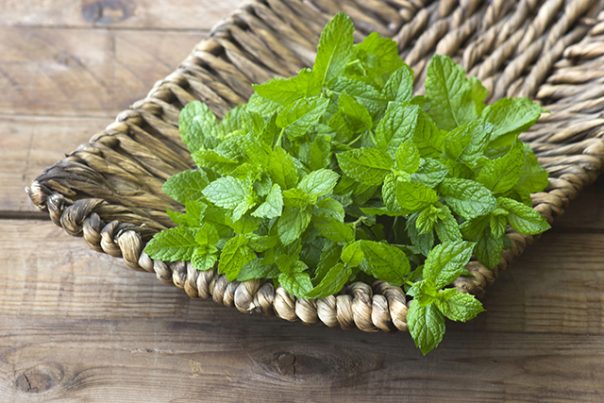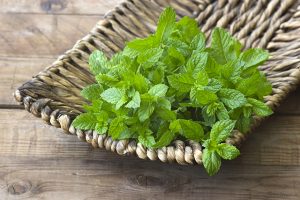
Mint – sources, health benefits, nutrients, uses and constituents at NaturalPedia.com
Thursday, July 06, 2017 by Frances Bloomfield
http://www.naturalpedia.com/mint-sources-health-benefits-nutrients-uses-and-constituents-at-naturalpedia-com.html

Mints, also known as mentha, are a genus of aromatic herbs which includes peppermint (Mentha piperita) and spearmint (Mentha spicata). In recent years, these plants have become synonymous with mouth and breath freshness owing to their repeated use in tooth pastes, chewing gums, and breath fresheners. Practitioners of folk medicine regard mints with more consideration, as these plants have numerous health benefits that range from clearing up congestion to providing relief from fatigue.

List of known nutrients
A noteworthy nutrient in mint is rosmarinic acid, a polyphenol with antioxidant, anti-inflammatory, and antimicrobial properties. The significance of rosmarinic acid to the body lies in its ability to block leukotrienes, which are inflammatory molecules that act as the main trigger for allergic reactions.
Mints have many different nutrients in varying amounts, particularly:
- Calcium
- Iron
- Magnesium
- Menthol
- Phosphorus
- Potassium
- Vitamin A
- Vitamin C
- Vitamin D
- Vitamin E
Medicinal uses for mints
Because of its anti-inflammatory and antioxidant qualities, rosmarinic acid is highly effective as a natural reliever of allergy symptoms, such as those associated with seasonal allergies and allergic rhinitis or hay fever.
There are numerous other conditions that mints can provide relief for, namely:
- Asthma
- Bronchitis
- Cancer
- Colds
- Colon disorders, including colitis
- Colic
- Congestion
- Conjunctivitis
- Halitosis
- Heart palpitations
- Hives
- Indigestion
- Influenza
- Intestinal parasites
- Irritable bowel syndrome (IBS)
- Mastitis
- Measles
- Mental fatigue
- Migraines
- Muscle cramps
- Nausea
- Neuralgia
- Sore throat
- Vomiting
Just like with the respiratory system, mints can deliver a cooling and calming effect to the skin. A topical application made with mints, such as a lotion or an ointment, can ease insect bites and rashes. In particular, the anti-pruritic properties mints make them potent against bites from mosquitoes and gnats. Moreover, mint juice is an exceptional skin cleanser and can reduce pimples.
Pregnant women can smell or consume a small number of mint leaves to relieve the nausea of morning sickness. Breastfeeding mothers can use mints as well: mints can sooth nipple discomfort, while mint oil and peppermint water can prevent nipple pain and nipple cracks in the breasts of women who are breastfeeding for the first time.
Mints promote digestion by activating salivary glands in the mouth and the glands that secrete digestive enzymes. This means that those who suffer from indigestion and digestive tract inflammation can turn to mints for relief from their symptoms. Those who have gastroesophageal reflux disease (GERD) shouldn’t take mints, however, as these herbs can exacerbate their condition. Mints relax the stomach and the sphincter, in turn making it easier for stomach acid to back up into the esophagus.
Body systems supported by mints
Mints possess a strong aroma that can soothe the respiratory system. By clearing congestion and alleviating irritation, mints can provide the lungs, nose, and throat with some much-needed relief from many common respiratory disorders.
Additionally, these herbs can be used for:
- Blood
- Circulatory system, including lymphatic system
- Digestive system, including bowels
- Liver
- Nervous system
- Smooth muscles
Ways to use mints
More than just serving as decorative greens, mints can be incorporated into a vast spectrum of dishes to infuse them with additional flavor. Specifically, dishes that are most common during the sweltering heat of summer. Juleps, homemade ice cream, summer salads, and smoothies can all be made even cooler with a few generous dashes of mint.
Mints do wonderfully in soothing teas, both hot and cold. Even water will benefit from the addition of mint sprigs and cucumber.
Note that mints are delicate herbs, so they’re best added during the last stages of food preparation or else they’ll lose their flavor and texture.
Where to learn more
- Ancient herbal mint remedy is effective, safe pain reliever, new study finds
- Common mint leaf destroys cancer tumors, new research reveals
- How to use mint for natural healing
- Mint is an Ancient Healing Food
- Mint: The Most Well Known Herb
Summary
Use mint as a topical ointment to ease insect bites and rashes.
Mint juice may also be used as a skin cleanser to reduce the appearance and formation of pimples.
Mint leaves can be used to relieve nausea symptoms in pregnant women.
Mint can be used to soothe nipple discomfort.
Mint can promote digestion.
Sources include:
TheHealthSite.com
MedicalNewsToday.com
OrganicFacts.net
Delish.com
EatThis.com
Tagged Under: Tags: Mint





